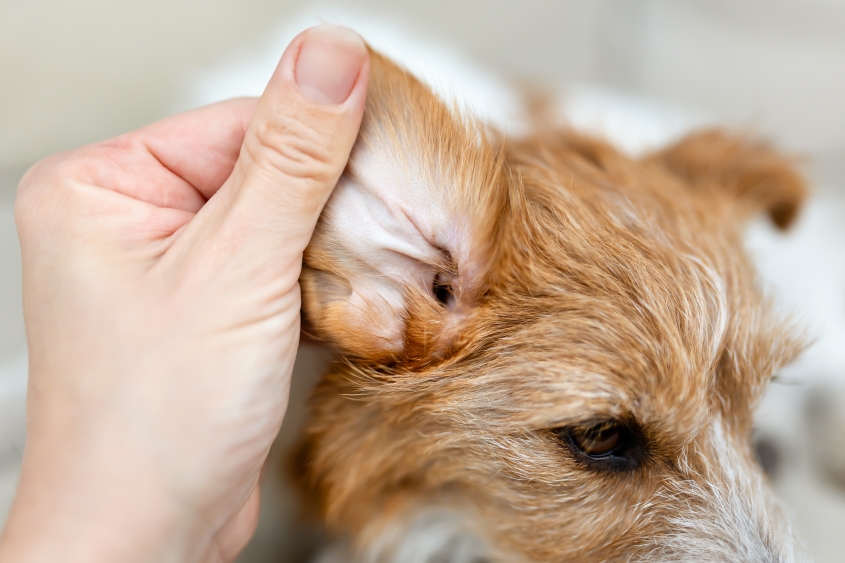How to Clean Your Dog’s Ears
Overview
Ear infections with bacteria or yeast are a commonly treated medical problem in dogs caused by underlying conditions such as allergies, ear mites, or certain breeds’ ear conformation. Several factors are involved in treating ear infections, and ear cleaning is one important aspect that needs to be performed before certain topical medications are applied. Ear cleanings are also often recommended as a maintenance routine for dogs prone to ear infections.
Why is cleaning my dog’s ears important if they have an infection?
Ear cleaning helps decrease debris, bacteria and yeast inside the ear. When a dog has an ear infection, excessive, abnormal debris is often present, making it difficult for the topical medications to reach the infection. Bacteria and yeast can easily hide inside layers of debris inside the ear canal and, if left behind after the treatment course has been completed, lead to reinfection of the ear. Certain types of ear discharge, such as purulent (pus) discharge, can even inactivate certain medications, preventing them from working.
If debris is packed deep into the ear canal, it can prevent the medication from reaching the deeper parts of the ear closer to the eardrum. This can also make it difficult or impossible for your veterinarian to evaluate the integrity of your dog’s ear drum.
How do I clean my dog’s ears at home?
The ears are very sensitive, so make the experience more comfortable for your dog by being as gentle as possible and rewarding them with plenty of positive reinforcement, like their favorite treats. You may opt to perform ear cleanings outside, weather permitting, or have a towel ready to avoid any mess from the ear cleaning solution.
Refer to the following steps for how to clean your dog’s ears:
- Fill the ear canal with ear cleaning solution. If your dog does not tolerate ear solution directly into the ear, try saturating cotton pads or balls with the ear cleaning solution instead.
- Gently massage the base of the ear. Have a towel ready, as once you stop massaging the ear, your dog will likely want to shake their head, which helps loosen the debris.
- Use cotton pads or cotton balls to gently wipe away debris. Start from the inside of the ear, only as far as your finger can easily fit, which is about one knuckle in, and work your way to the outside ear flap. Avoid using cotton swabs to prevent pushing debris deeper into the ear canal.
If your dog seems to be in pain during an ear cleaning, stop and consult with your veterinarian. Often, at-home ear cleanings for treating severe infections may be delayed for the first few days until the medication helps improve the pain and inflammation.
What type of ear cleaner should I use?
Many types of ear cleaning solutions are available and some may be better for certain types of infections, removal of waxy buildup, or routine maintenance cleaning. In general, avoid anything with alcohol or hydrogen peroxide in the solution. If your dog has an ear infection, your veterinarian can help you pick the most appropriate ear cleaner to help manage the infection.
How often should I clean my dog’s ears?
The frequency of cleaning your dog’s ears will depend on whether it is for treatment of an infection, which could be up to daily to start, or maintenance, which could be every 1-2 weeks. Dogs with a history of allergies, recurrent ear infections, or floppy ears may need their ears cleaned more frequently. For a dog with healthy, normal ears, a routine ear clean is only needed if dirt or debris is noted, as overcleaning the ears can also lead to irritation of the ears. A routine ear cleaning is recommended if the ears get wet, such as after swimming or bathing.
How do I know if my dog has an ear infection?
Regularly check your dog’s ears for signs of infection, which may include:
- Redness
- Itching one or both ears
- Headshaking
- Discharge or increased wax in the ear
- Odor
- Discomfort when touching the ear.
If you suspect your dog has an ear infection, contact your veterinarian. Some of these signs are also present in dogs with allergic ear disease, even when ear infections are absent.
This page was last updated on Tuesday, Oct 21, 2025




